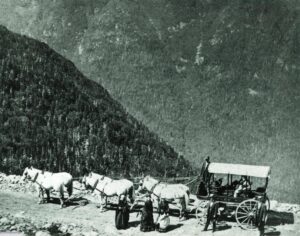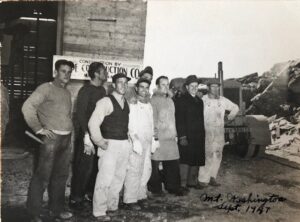 Climbing Mount Washington with a view of the other Presidential Mountains, ca. 1870. Courtesy of the Mt. Washington Auto Road website
Climbing Mount Washington with a view of the other Presidential Mountains, ca. 1870. Courtesy of the Mt. Washington Auto Road website
New Hampshire has a special place in my heart. My friends and I camp in the White Mountains every summer and each year we find something new to visit. One summer, we made it up Mount Washington. Everyone in New England knows the “This Car Climbed Mt. Washington” bumper stickers. But do people know enough about Mount Washington’s history? It’s full of human perseverance, courage, and innovation. Its main claim to fame is that on the summit in 1934, the highest wind speed ever was recorded. The record was held till 1996, but it is still the highest wind speed recorded that is not associated with a tornado or a cyclone.
Standing on top of Mount Washington, I not only found it to be beautiful and spiritually grounding, but I also found it inspiring. Especially since my great-grandfather, former Massachusetts Governor John A. Volpe, had ties to the highest peak in the Northeastern United States.
Many family histories are passed down orally, and this story is one of them. Apparently, my great-grandfather, who had his own construction company, helped build the observatory on the the mountain’s peak. When I was at Mount Washington, I asked the employees there for any information – they had none. I was disgruntled. I knew my grandmother wasn’t making this story up, so I had to know more about it. I had to find proof.
 My great-grandfather John A. Volpe (second from the right) with his employees. Behind them is the Volpe Construction Company sign. Mount Washington, September 1947
My great-grandfather John A. Volpe (second from the right) with his employees. Behind them is the Volpe Construction Company sign. Mount Washington, September 1947
Sure enough, I received more family photos (since I’m the archivist for both sides of my family—look at my blog post, “The Family Archivist”). And in that box I found a photo: my great-grandfather, John A. Volpe, and his workers at Mount Washington. (One worker was his relative, an Italian immigrant who happened to be a mason—how handy!)
After using my heightened googling powers, I found an article in Volume 178 of Scientific American, published in 1948, that mentions the Volpe Construction Company from Malden, Massachusetts. The article states that Volpe actually built an airplane hangar on top of the mountain. Apparently, Mount Washington was used as a testing site for the technology of de-icing airplanes. An airplane would be hauled up the winding road to the peak where it would be stored in the hangar before flying into frigid conditions. Tests would be initiated so engineers “might try to correlate engine and wing icing conditions... One of the pertinent questions that the scientists hope[d] to be able to answer as a result of this research [was]: [would] the jet engine or the plane’s wings ice up first under Arctic conditions?”[1]
I always love learning how my relatives contributed to major feats like this. There is always a long line of human participation, determination, and skill that is needed to produce a result, a feat, or a scientific discovery in order to improve humans’ lives. And my great-grandfather and his employees were a part of that.
Believe it or not, I only researched this for an hour, so there is still a lot to do. For instance, what about the weather observatory? I’ll find the records, don’t worry, family.
Do you have a relative who is connected to Mount Washington in some way? Perhaps one of those ladies (shown above) who wore full-length Victorian dresses up the mountain?!
Sources
“History of the Road” and “World Record Wind,” Mt. Washington Auto Road. Online
Michael Sheridan, “The Worst Weather in the World,” Scientific American 178 [1948]: 154-55.
Note
[1] Michael Sheridan, “The Worst Weather in the World,” Scientific American 178 [1948]: 154.
Share this:

About Geneva Cann
A member of the Research Services team, Geneva studied at Smith College and St. Mary’s College of Maryland, graduating with a BA in History and Museum Studies. Before joining the NEHGS staff, she interned at the Peabody Essex Museum in Salem, Massachusetts. She also interpreted at Historic St. Mary’s City, a living history museum in Maryland, as an indentured servant from 1667. Geneva enjoys traveling, reading about the history of the American West, playing piano, and continuing her role as her family's archivist.View all posts by Geneva Cann →